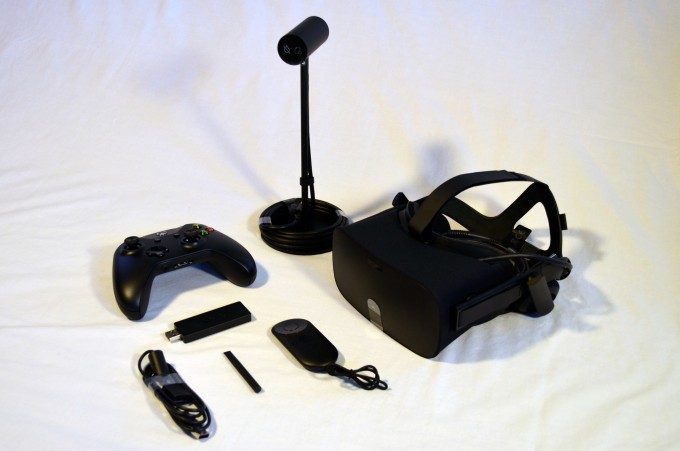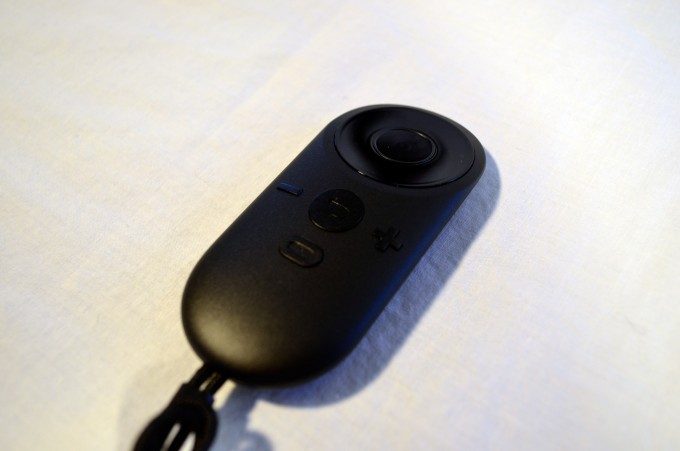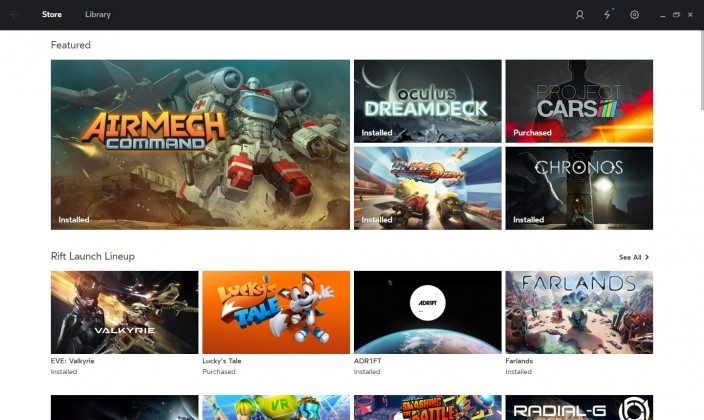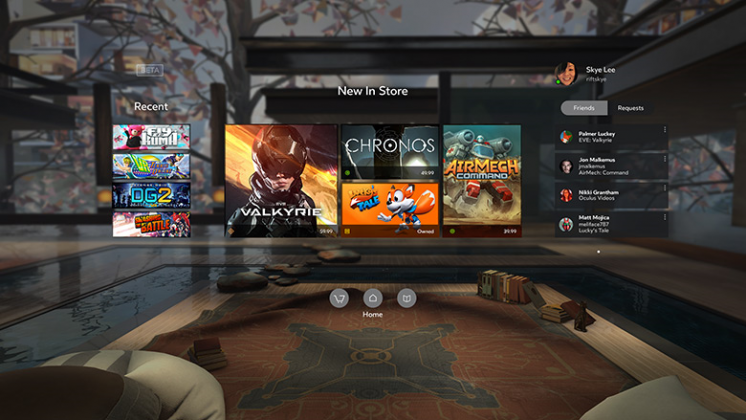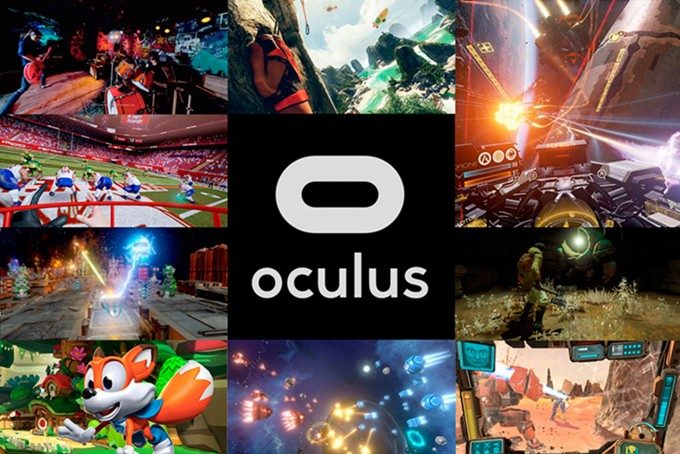Table of Contents
Setup & Experience
Plug and Play
Getting the Oculus Rift up and running was a buttery smooth process, especially compared to the tribulations endured by those of us who used the Rift DK1 or DK2.
 The Oculus desktop software walks you through a polished setup wizard which tells you what to plug in and when. The Rift has a single cable which ends with an HDMI and USB port, while the Sensor has a cable ending in a single USB port. The hardware setup is really just plugging in the Sensor and sitting it on your desk, then plugging in the Rift.
The Oculus desktop software walks you through a polished setup wizard which tells you what to plug in and when. The Rift has a single cable which ends with an HDMI and USB port, while the Sensor has a cable ending in a single USB port. The hardware setup is really just plugging in the Sensor and sitting it on your desk, then plugging in the Rift.
Once that’s done, you can immediately jump into VR using the Remote which is configured seamlessly, with no need to pair or install it.
While the Remote is the easiest way to start poking around in VR, you will want to hook up the included wireless Xbox gamepad by plugging in the wireless dongle and syncing the controller. The controller is used for games that require more complex input, but a number of experiences will work just fine with the Remote.
Once your headset is configured correctly, you’ll be first taken into Oculus Dreamdeck which will tour you through a few of the Oculus-made experiences that we first saw back when the company revealed the ‘Crescent Bay’ headset prototype. Later, you’ll be able to launch Dreamdeck from the library to see an extended set of vignettes.
Experience
The Oculus desktop app and Oculus Home in VR are your portal to using the Rift. Just like on Gear VR, Oculus Home allows you to browse and purchase titles while also acting as your content library, VR launcher, and friends list.
Fresh from booting your PC, you can actually put on your Rift and in a few seconds you’ll appear in Oculus Home, without having to launch a single thing on your computer first. Pretty slick. Taking the headset off freezes games automatically and turns off the display, thanks to an onboard proximity sensor.
Universal Menu & Calibration Tool
You can access the Universal Menu at any time by holding the Xbox button on the gamepad, or pressing the Oculus button on the Remote. Here you can access a simple calibration tool to help hone the sweet spot and get the sharpest image.
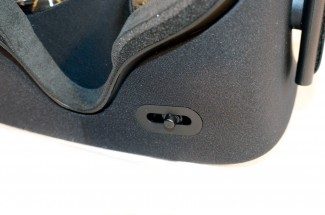
The calibration tool shows a green plus sign and asks you to move your Rift up and down on your face the get the horizontal line as sharp as possible. Then you can use the IPD adjustment dial on the headset to get the vertical line equally sharp (you can also see a readout of the actual IPD setting in this tool which updates as you make changes).
The Rift launch lineup is impressive in that there seems to be a little something for every gamer, even at this early stage, which I think is hugely important. From racing to dungeon crawlers to even pinball, the Rift launch lineup has something that you’ll want to try.
We’ll be breaking out individual reviews soon, but check out the Rift launch lineup and our previews:
Oculus Names 30 Rift Launch Titles and Their Prices
Many of the games at this point go beyond the ‘experiences’ we’ve come to know from the development days of VR—those 5 to 10 minute demos that show something neat, but are just teasers. Many of the titles in Oculus’ curated launch catalog feel like real games that you will want to spend time in (and money on).
Oculus Dreamdeck, as mentioned earlier, is a series of VR vignettes which originally premiered at the introduction of the Rift ‘Crescent Bay’ prototype some time ago. This is an excellent introduction for first time VR users and even non-gamers as it’s an entirely passive experience, but shows lots of different experiences which get the imagination juices flowing for newbies.
Conclusion & The Virtual Elephant in the Room
The Rift feels like a near-perfect execution of the device Oculus promised they would make back during their 2012 Kickstarter. It’s a VR headset that lets us “step into the game” in a powerfully immersive way that’s unlike anything you’ve seen before (assuming you’ve never tried VR). The user-experience so far is exceptional, which is especially impressive given the scope of today’s launch (the product, drivers, the Oculus Home platform for desktop, 30 launch titles, etc).
But a lot has happened in the world of VR since that 2012 vision—most notably the introduction of high performance motion input controllers which radically enhance the level of interactivity (and in many ways immersion) of virtual reality.
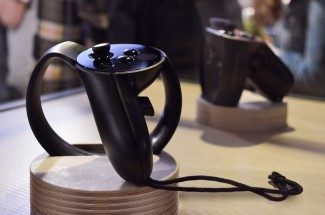
Oculus will of course be shipping their own motion input controllers (called Touch) in the second half of 2016, but with the HTC Vive including motion controllers in the box right from the get-go (and launching next week), the Rift is left with what feels like a significant missing piece for anyone that has already experienced great motion input.
The good news is that anyone who is getting into VR for the first time (not having tried motion input prior) will probably be blown away by the Rift even without Touch. And then when Touch joins the party a little further down the road, those new users will be further surprised at how much motion input adds to the VR experience.
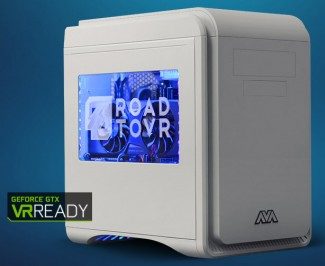 This review was produced by testing the Rift on the Road to VR Exemplar Ultimate, our top-end system designed to push virtual reality experiences above and beyond what’s possible with systems built to lesser recommended VR specifications. The Exemplar Ultimate is the reference point for gamers who demand the best virtual reality experience.
This review was produced by testing the Rift on the Road to VR Exemplar Ultimate, our top-end system designed to push virtual reality experiences above and beyond what’s possible with systems built to lesser recommended VR specifications. The Exemplar Ultimate is the reference point for gamers who demand the best virtual reality experience.
In celebration of the launch of the Oculus Rift and (soon) HTC Vive, you can save $150 off the Exemplar Ultimate using code ‘VRLAUNCH2016‘ through April 8th.
Disclosure: Oculus provided Road to VR with a loaner Rift and PC to facilitate this review.

